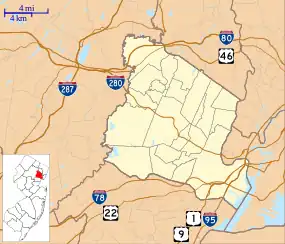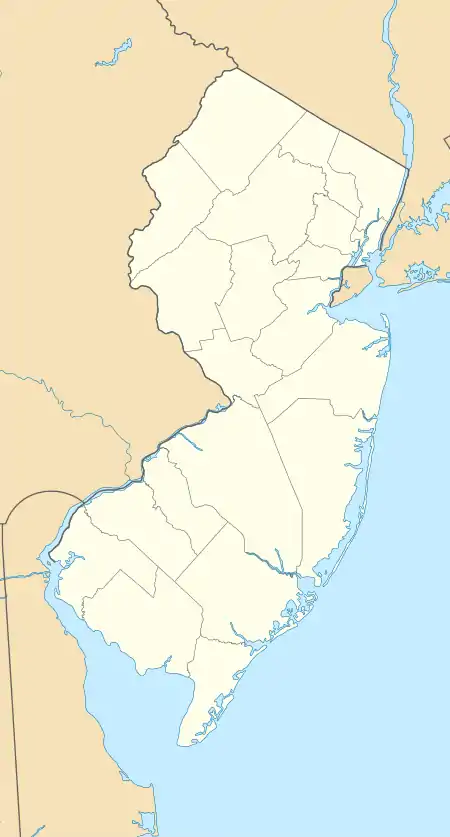East Orange | |||||||||||||||||||||||||||
|---|---|---|---|---|---|---|---|---|---|---|---|---|---|---|---|---|---|---|---|---|---|---|---|---|---|---|---|
 The East Orange station in April 2015, facing toward Brick Church. | |||||||||||||||||||||||||||
| General information | |||||||||||||||||||||||||||
| Location | 65 City Hall Plaza, East Orange, New Jersey | ||||||||||||||||||||||||||
| Owned by | New Jersey Transit | ||||||||||||||||||||||||||
| Platforms | 1 side platform and 1 island platform | ||||||||||||||||||||||||||
| Tracks | 3 | ||||||||||||||||||||||||||
| Connections | |||||||||||||||||||||||||||
| Construction | |||||||||||||||||||||||||||
| Accessible | Yes | ||||||||||||||||||||||||||
| Other information | |||||||||||||||||||||||||||
| Fare zone | 4 | ||||||||||||||||||||||||||
| History | |||||||||||||||||||||||||||
| Opened | November 19, 1836[1] | ||||||||||||||||||||||||||
| Rebuilt | April 21, 1921–December 18, 1922[2] | ||||||||||||||||||||||||||
| Electrified | September 22, 1930[3] | ||||||||||||||||||||||||||
| Previous names | Orange Junction[4] | ||||||||||||||||||||||||||
| Passengers | |||||||||||||||||||||||||||
| 2017 | 455 (average weekday)[5][6] | ||||||||||||||||||||||||||
| Services | |||||||||||||||||||||||||||
| |||||||||||||||||||||||||||
| |||||||||||||||||||||||||||
East Orange Station | |||||||||||||||||||||||||||
 East Orange station depot | |||||||||||||||||||||||||||
 Location in Essex, County, New Jersey  East Orange station (New Jersey)  East Orange station (the United States) | |||||||||||||||||||||||||||
| Coordinates | 40°45′40.8″N 74°12′39.5″W / 40.761333°N 74.210972°W | ||||||||||||||||||||||||||
| Built | 1921 | ||||||||||||||||||||||||||
| Architect | F.W. Nies | ||||||||||||||||||||||||||
| Architectural style | Tudor Revival, Jacobethan Revival | ||||||||||||||||||||||||||
| MPS | Operating Passenger Railroad Stations TR | ||||||||||||||||||||||||||
| NRHP reference No. | 84002638[7] | ||||||||||||||||||||||||||
| Added to NRHP | June 22, 1984 | ||||||||||||||||||||||||||
East Orange is an active commuter railroad train station in the city of East Orange, Essex County, New Jersey. Located next to East Orange City Hall, the station serves trains on the two lines that make up New Jersey Transit's Morris and Essex Lines: the Morristown Line and Gladstone Branch. Trains heading east to New York Penn Station and Hoboken Terminal stop at Newark Broad Street Station next, while trains heading west towards Gladstone and Hackettstown stop at Brick Church station. East Orange station contains two platforms (one side platform and one island platform) to service three active tracks. The station is accessible for handicapped persons per the Americans with Disabilities Act of 1990.
Service in East Orange began on November 19, 1836 when the Morris and Essex Railroad opened to Orange. Originally the station was known as Orange Junction as the name East Orange was assigned to the now-closed Grove Street station to the east.[4] The current station at the location opened on December 18, 1922 when the Delaware, Lackawanna and Western Railroad completed an elevation project of the tracks through the city. The headhouse at East Orange station were added to the New Jersey and National Registers of Historic Places in 1984 as part of the Operating Passenger Railroad Stations Thematic Resource.[8][9]
History
Station owner New Jersey Transit decided to perform work at East Orange station to improve accessibility for the handicapped and to repair eighty-year-old viaducts at the station.[10] At a cost of $22.9 million, repair work at East Orange, along with nearby station Brick Church commenced in 2004.[11] East Orange received a mini-high level platform, the tracks surrounding the station were upgraded with concrete ties and the stairways leading to the platforms were replaced.[12]
Station layout
The station has two low-level platforms serving all three tracks.
| P Platform level |
Side platform, doors will open on the right | |
| Track 3 | ← Morristown Line toward Dover or Hackettstown (Brick Church) ← Gladstone Branch weekdays toward Gladstone (Brick Church) | |
| Track 1 | ← Morristown Line toward Dover or Hackettstown (Brick Church) ← Gladstone Branch weekdays toward Gladstone (Brick Church) Morristown Line, Gladstone Branch toward Hoboken or New York (Newark Broad Street) → | |
| Island platform, doors will open on the left or right | ||
| Track 2 | Morristown Line, Gladstone Branch toward Hoboken or New York (Newark Broad Street) → | |
| G | Street level | Station building, ticket machines, parking |
See also
Bibliography
- Douglass, A.M. (1912). The Railroad Trainman, Volume 29. Cleveland, Ohio: Brotherhood of Railroad Trainmen. Retrieved April 5, 2020.
References
- ↑ Douglass 1912, p. 339.
- ↑ "D., L. & W. Opens New Elevated Line". The Paterson Evening News. December 18, 1922. p. 1. Retrieved March 5, 2019 – via Newspapers.com.

- ↑ "Edison Pilots First Electric Train Over Orange-Hoboken Route". The Passaic Daily News. September 22, 1930. p. 5. Retrieved January 31, 2021 – via Newspapers.com.

- 1 2 40 Miles Around New York (Map). New York, New York: H.H. Lloyd and Co. 1867. Retrieved November 8, 2022.
- ↑ "QUARTERLY RIDERSHIP TRENDS ANALYSIS" (PDF). New Jersey Transit. Archived from the original (PDF) on April 19, 2013. Retrieved January 4, 2013.
- ↑ "How Many Riders Use NJ Transit's Hoboken Train Station?". Hoboken Patch. Retrieved July 18, 2018.
- ↑ "National Register Information System". National Register of Historic Places. National Park Service. July 9, 2010.
- ↑ Monmouth County Listings, National Register of Historic Places. Accessed September 2, 2007.
- ↑ East Orange New Jersey Transit Railroad Station Survey
- ↑ M&E station improvement and viaduct rehabilitation NJ Transit official site Retrieved August 6, 2007
- ↑ NJ Transit approves $22.9 million in viaduct repairs Progressive Railroading Retrieved August 6, 2007
- ↑ NJ Transit breaks ground on three-station rehab project Progressive Railroading Retrieved August 7, 2007
External links
![]() Media related to East Orange (NJT station) at Wikimedia Commons
Media related to East Orange (NJT station) at Wikimedia Commons
